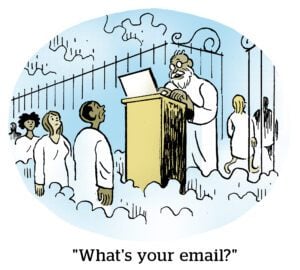Over the long weekend, the weather in New York City was beautiful … but rather than taking in the sunshine, some of us (yes, me) spent most of their time in bed taking advantage of big discounts on streaming services.
In honor of National Streaming Day – an informal holiday cooked up by Roku in 2014 that takes place every May 20 – several streaming services celebrated by slashing the price of their subscriptions.
The “holiday” has a similar purpose to Black Friday, which is to offer steep discounts so that sales skyrocket.
The difference for streaming services is their hope that new subscribers will stick around and start paying full price after the discounts expire.
But even if subscribers who signed up at a discount don’t stay, streaming services with an ad-supported option can at least make advertising revenue for the duration of the deal.
Now more than ever before, platforms are desperate to generate enough profits to keep investors impressed and enough scale to keep advertisers happy.
Digging for deals
This heated competition for subscribers is evidenced by how much streaming services were willing to lower their prices.
Last week, Hulu marketed a three-month subscription deal for its ad-supported offering at just $2 per month, a 75% discount from $7.99 per month for Hulu with ads. New Hulu subscribers also had the option to tack on a two-month Disney+ subscription with ads for an additional $2 per month.
Peacock offered an annual subscription for its ad-supported tier at $19, a 60% drop from the original $49.99 per year price tag. Meanwhile, Apple TV+, which isn’t picking up subscribers as fast as its competition, dangled free three-month subscriptions before new users.
Not to be left out, Roku, inventor of National Streaming Day, allowed Roku device owners to sign up for two months of Peacock without ads for $.99 per month. The same deal was available for STARZ, although non-Roku users were only offered three months of STARZ for $5 per month.
Normally, Peacock without ads costs $9.99 per month at full price, and STARZ costs $9 per month.
Roku also offered two-month subscriptions for $.99 per month to BET+ and ad-free Paramount+.
Weighing the risks
Offering steep discounts can be a useful marketing tactic, but there’s no guarantee the pitch will produce profits. A streaming service could lose out on potential profits if not enough people sign up, and not every platform was willing to take the risk.
Netflix, for example, didn’t lower its prices last week, nor did Warner Bros. Discovery (WBD) offer discounts for Max, its new streaming service that combines HBO Max and Discovery+ content.
It’s possible that the risk of dropping prices was just too great for these two new AVOD services. New streaming business models are under a lot of pressure to prove long-term profitability early on, and offering steep discounts too close to launch adds more uncertainty to initial revenue growth rates. Disney+ is also new to ads, but Disney has a majority stake in Hulu and leaned on Hulu to market both services last week.
Netflix is especially under a lot of scrutiny from advertisers and investors because its ad-supported tier isn’t picking up subscribers quickly enough. With anti-password sharing in place, the hope is that the people booted off of shared accounts sign up for Netflix’s ad-supported tier. But subscribers may choose to downgrade to the cheaper ad-free offering instead, which would cut into Netflix’s average revenue per user (ARPU).
Streaming services are focused on ARPU to demonstrate profitability. Netflix’s position is precarious enough that it can’t afford any declines by offering discounted access to content.
It’s a similar story for WBD, which previously had Memorial Day deals for HBO Max, but isn’t doing the same for Max this year. WBD needs to prove to stakeholders that its brand-new streaming service is profitable, and releasing it at a discount (Max launched on May 23) isn’t the best way to start making money.
What I’m wondering is: How much profit do streaming services really make from National Streaming Day discounts?
📣 ALSO: You can catch me at the Cynopsis Measurement and Data Conference in New York City next month. I’ll be moderating a panel about CTV measurement on Tuesday, June 13. (Please note the date change from Wednesday, June 14.) Check out the agenda here. AdExchanger readers get a 25% discount on registration with the code ADEXCH25.
Let me know what you think. Hit me up at [email protected].



















